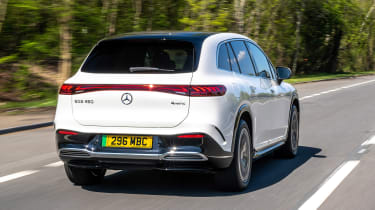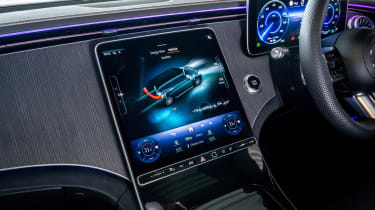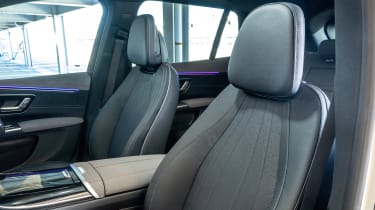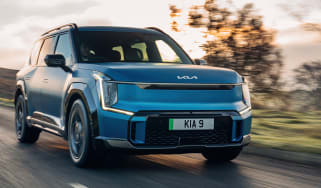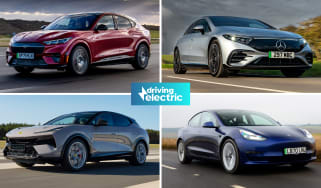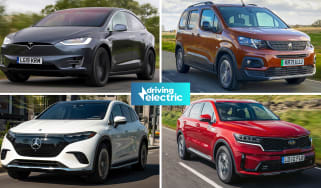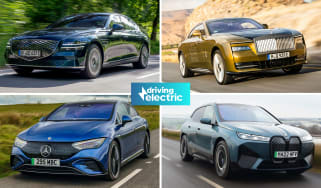Mercedes EQS SUV review
Mercedes’ flagship electric car gets the SUV treatment – boasting seating for seven and a 365-mile range
Pros
- Excellent refinement
- Sublime comfort
- Huge rear cabin
Cons
- Extremely expensive
- Uninvolving to drive
- Not very efficient
| Model | Electric range | Wallbox charge time | Rapid charge |
|---|---|---|---|
| EQS 450 4MATIC | 362-365 miles | 10 hours (0-100%, 11kW) | 31 mins (10-80%, 200kW) |
| EQS 580 4MATIC | 362-364 miles | 10 hours (0-100%, 11kW) | 31 mins (10-80%, 200kW) |
Before too long, there will be an electric version of every Mercedes model. The maker’s EQ range started only with the EQC, but now spans nine distinct cars – including a number of SUVs. The EQS SUV is the biggest and most expensive, representing the pinnacle of Merc’s technological advances.
We first drove the Mercedes EQS SUV in the US in 2022, praising it for its long range, impressive interior design and cutting-edge hardware. But the true test of any car comes on UK roads. Our tarmac is quite unlike any other; if a car can perform here, it’ll do the job near enough anywhere.
So here we are: the EQS SUV uses the same platform and hardware as the luxury Mercedes EQS limousine, adding a raised ride height, more practical body, and seating for seven. But it's obviously less aerodynamic and there’s a weight penalty – as is often the case with SUVs – so efficiency takes a hit compared to the regular EQS.
The EQS SUV boasts a maximum range of 365 miles in entry-level EQS 450 4MATIC AMG Line Premium Plus guise, while the more powerful EQS 580 4MATIC and 450 versions in Business Class spec – drop a few miles from that outright maximum. A lighter rear-wheel drive 450+ is offered in other markets, but all UK cars come with all-wheel drive as standard.
Efficiency, as you might expect for something weighing more than 2.6 tonnes, isn’t great. Mercedes claims between 2.5 and 3.0 miles per kilowatt-hour depending on specification, but during our time with the car, the average sat at the lower end of that range. All told, we were seeing a comfortable 250-270 miles on a charge – a little shy of what we achieved in a BMW iX xDrive50 in normal driving, while still offering strong flexibility to higher-mileage drivers.
The Mercedes EQS SUV boasts rapid top-ups of 200kW, meaning a 10-80% charge should be achievable in just over half-an-hour – all without the complex 800-volt electrics found on fast-charging rivals like the Porsche Taycan. One of the main downsides of the Mercedes’ huge 108.4kWh battery is lengthy home charge times; the EQS supports 22kW AC charging, but topping up on a more conventional 7.4kW wallbox will take upwards of 17 hours.
While high running costs likely won’t be a problem for most EQS owners, it’s important to not be deceived by the rhetoric that all electric cars are cheap to run; charging the EQS SUV at home at the average electricity rate (at the time of writing) of 34p per kWh, means a full charge will cost owners £36.86. While that may not seem so bad, the average cost of using a public ultra-rapid charger – according to a study by the RAC – is around 74p per kWh, meaning a full charge will cost roughly £80 – almost as much as filling up a combustion-engined SUV with petrol.
Elsewhere, interior quality, as you’d hope from something costing £130,000 and up, is exquisite. There are solid-feeling woods and metals dotted around the cabin – we especially like how the Mercedes three-pointed star is subtly inlaid into the dashboard trim – and the leather used for the seats, dashboard and doors is first rate. Those seats – all seven of them – are plush and super supportive, with pillow-like headrests and adjustable lumbar support.

The interior technology on offer is among the best in the business too, even without the circa £8,000 Hyperscreen infotainment system. We actually prefer the standard twin-screen set-up; it’s easier to use, less distracting and still has all the functionality you’d wish for. Save yourself the cash and spend it on something else – most notably, insurance, as all versions of the EQS sit in the most-expensive insurance group 50.
On the move, the first thing you notice is how quiet the EQS SUV is – arguably even more so than the calm, cosseting EQS saloon. The extra ride height gives you a commanding view of the road, but refinement remains unbeatable. In fact, we can say with some confidence that there is no quieter car to travel long distances in.
The ride isn’t perfect, though. It’ll waft along nicely on smooth roads and the motorway, but rougher sections and bigger bumps can send thumps through the standard-fit air suspension – almost as if the system isn’t quite quick enough to react.
Added to this (and perhaps more predictably) we found the EQS SUV to be rather uninvolving to drive. The 450 4MATIC doesn’t feel its weight in a straight line – though those wanting Tesla-baiting performance should look to the EQS 580 – but the mass isn’t as easy to disguise through the corners. The rear-axle steering helps with agility, but there’s no avoiding this car’s bulk.
Ultimately, a BMW iX is more fun to drive. The way that car hunkers down and rewards the keen driver is not something that the EQS SUV can replicate. Furthermore, the Merc’s regenerative braking cannot compete with the one-pedal option offered by rivals. Brake feel is inconsistent, and at times the pedal gives the sensation it’s being pulled away from your right foot, which can be quite disconcerting.
But what the EQS lacks in the driving department, it more than makes up for when it comes to space and practicality. It’s a shame there isn’t any storage under the bonnet, but you’ll find space beneath the boot floor for the charging cables.
Even seven-seat versions offer some space behind the rearmost seats for soft bags, but folding these chairs into the floor boosts load volume to an acceptable 565 litres. All-in, with all five rear seats stowed, the EQS – thanks to its tall roofline – can carry up to 2,020 litres.
That high roof works wonders for rear seat room. One of the EQS saloon’s biggest failings – at least compared with the petrol, diesel and plug-in hybrid Mercedes S-Class – was space in the back. In the SUV, however, there is enough head, leg and shoulder room for even the tallest adults to get comfy in the middle row. Seats six and seven are tighter; these are best reserved for kids, but can be used by adults for shorter journeys.
Prices for the EQS SUV 450 4MATIC in the UK start from a smidge under £130,000, while the more powerful EQS 580 4MATIC adds £10,000 to the flagship EV’s price tag. Both versions come in AMG Line Premium Plus trim as standard, equipped with 21-inch wheels, adaptive LED headlights, Nappa leather seats, anthracite wood trim, a heated steering wheel, heated and ventilated front seats and a 360-degree parking camera. Not to mention a Burmester stereo, a panoramic glass roof and a head-up display with an augmented reality navigation system.
You can add Mercedes’ Hyperscreen infotainment system for £7,995, or it comes as part of the Business Class specification (£14,325) which also adds screens for the second row of seats. The materials used get an upgrade too, with this trim level also including open-pore wood trim and special, contoured leather for the seats, among other things.
It’s certainly expensive, but if you’ve got the cash the new Mercedes EQS SUV is one of the most luxurious electric cars available right now. It’s imposing, quiet, refined, spacious and loaded with the best materials and technology this brand has to offer. But that doesn’t mean it's flawless, in fact there are some areas where the luxury seven-seater doesn't live up to its price tag. Perhaps the fully electric Range Rover – or even the Volvo EX90 – are worth holding out for.

